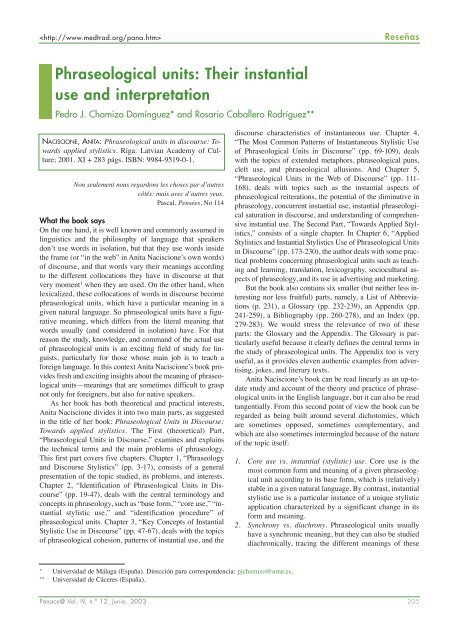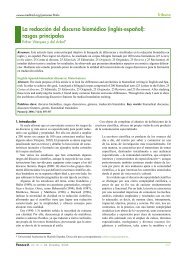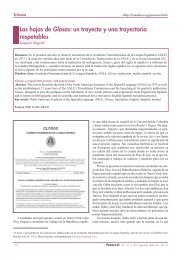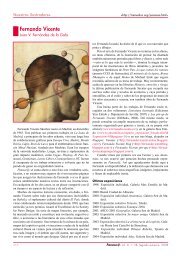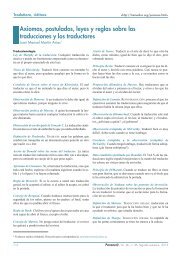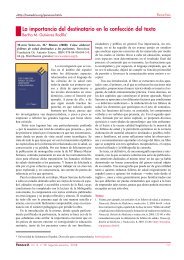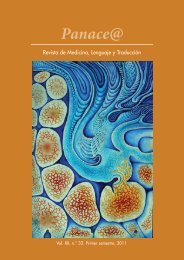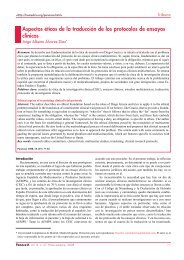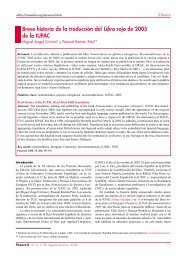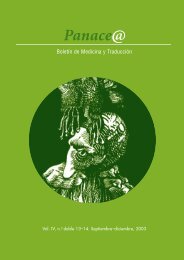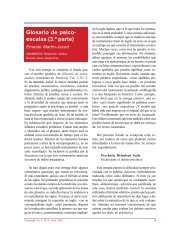Phraseological units: Their instantial use and interpretation
Phraseological units: Their instantial use and interpretation
Phraseological units: Their instantial use and interpretation
You also want an ePaper? Increase the reach of your titles
YUMPU automatically turns print PDFs into web optimized ePapers that Google loves.
Reseñas<strong>Phraseological</strong> <strong>units</strong>: <strong>Their</strong> <strong>instantial</strong><strong>use</strong> <strong>and</strong> <strong>interpretation</strong>Pedro J. Chamizo Domínguez* <strong>and</strong> Rosario Caballero Rodríguez**NACISCIONE, ANITA: <strong>Phraseological</strong> <strong>units</strong> in discourse: Towardsapplied stylistics. Riga: Latvian Academy of Culture;2001. XI + 283 págs. ISBN: 9984-9519-0-1.Non seulement nous regardons les choses par d’autrescôtés: mais avec d’autres yeux.Pascal, Pensées, No 114What the book saysOn the one h<strong>and</strong>, it is well known <strong>and</strong> commonly assumed inlinguistics <strong>and</strong> the philosophy of language that speakersdon’t <strong>use</strong> words in isolation, but that they <strong>use</strong> words insidethe frame (or “in the web” in Anita Naciscione’s own words)of discourse, <strong>and</strong> that words vary their meanings accordingto the different collocations they have in discourse at thatvery moment 1 when they are <strong>use</strong>d. On the other h<strong>and</strong>, whenlexicalized, these collocations of words in discourse becomephraseological <strong>units</strong>, which have a particular meaning in agiven natural language. So phraseological <strong>units</strong> have a figurativemeaning, which differs from the literal meaning thatwords usually (<strong>and</strong> considered in isolation) have. For thatreason the study, knowledge, <strong>and</strong> comm<strong>and</strong> of the actual <strong>use</strong>of phraseological <strong>units</strong> is an exciting field of study for linguists,particularly for those whose main job is to teach aforeign language. In this context Anita Naciscione’s book providesfresh <strong>and</strong> exciting insights about the meaning of phraseological<strong>units</strong>—meanings that are sometimes difficult to graspnot only for foreigners, but also for native speakers.As her book has both theoretical <strong>and</strong> practical interests,Anita Naciscione divides it into two main parts, as suggestedin the title of her book: <strong>Phraseological</strong> Units in Discourse:Towards applied stylistics. The First (theoretical) Part,“<strong>Phraseological</strong> Units in Discourse,” examines <strong>and</strong> explainsthe technical terms <strong>and</strong> the main problems of phraseology.This first part covers five chapters. Chapter 1, “Phraseology<strong>and</strong> Discourse Stylistics” (pp. 3-17), consists of a generalpresentation of the topic studied, its problems, <strong>and</strong> interests.Chapter 2, “Identification of <strong>Phraseological</strong> Units in Discourse”(pp. 19-47), deals with the central terminology <strong>and</strong>concepts in phraseology, such as “base form,” “core <strong>use</strong>,” “<strong>instantial</strong>stylistic <strong>use</strong>,” <strong>and</strong> “identification procedure” ofphraseological <strong>units</strong>. Chapter 3, “Key Concepts of InstantialStylistic Use in Discourse” (pp. 47-67), deals with the topicsof phraseological cohesion, patterns of <strong>instantial</strong> <strong>use</strong>, <strong>and</strong> thediscourse characteristics of instantaneous <strong>use</strong>. Chapter 4,“The Most Common Patterns of Instantaneous Stylistic Useof <strong>Phraseological</strong> Units in Discourse” (pp. 69-109), dealswith the topics of extended metaphors, phraseological puns,cleft <strong>use</strong>, <strong>and</strong> phraseological allusions. And Chapter 5,“<strong>Phraseological</strong> Units in the Web of Discourse” (pp. 111-168), deals with topics such as the <strong>instantial</strong> aspects ofphraseological reiterations, the potential of the diminutive inphraseology, concurrent <strong>instantial</strong> <strong>use</strong>, <strong>instantial</strong> phraseologicalsaturation in discourse, <strong>and</strong> underst<strong>and</strong>ing of comprehensive<strong>instantial</strong> <strong>use</strong>. The Second Part, “Towards Applied Stylistics,”consists of a single chapter. In Chapter 6, “AppliedStylistics <strong>and</strong> Instantial Stylistics Use of <strong>Phraseological</strong> Unitsin Discourse” (pp. 173-230), the author deals with some practicalproblems concerning phraseological <strong>units</strong> such as teaching<strong>and</strong> learning, translation, lexicography, sociocultural aspectsof phraseology, <strong>and</strong> its <strong>use</strong> in advertising <strong>and</strong> marketing.But the book also contains six smaller (but neither less interestingnor less fruitful) parts, namely, a List of Abbreviations(p. 231), a Glossary (pp. 232-239), an Appendix (pp.241-259), a Bibliography (pp. 260-278), <strong>and</strong> an Index (pp.279-283). We would stress the relevance of two of theseparts: the Glossary <strong>and</strong> the Appendix. The Glossary is particularly<strong>use</strong>ful beca<strong>use</strong> it clearly defines the central terms inthe study of phraseological <strong>units</strong>. The Appendix too is very<strong>use</strong>ful, as it provides eleven authentic examples from advertising,jokes, <strong>and</strong> literary texts.Anita Naciscione’s book can be read linearly as an up-todatestudy <strong>and</strong> account of the theory <strong>and</strong> practice of phraseological<strong>units</strong> in the English language, but it can also be readtangentially. From this second point of view the book can beregarded as being built around several dichotomies, whichare sometimes opposed, sometimes complementary, <strong>and</strong>which are also sometimes intermingled beca<strong>use</strong> of the natureof the topic itself:1. Core <strong>use</strong> vs. <strong>instantial</strong> (stylistic) <strong>use</strong>. Core <strong>use</strong> is themost common form <strong>and</strong> meaning of a given phraseologicalunit according to its base form, which is (relatively)stable in a given natural language. By contrast, <strong>instantial</strong>stylistic <strong>use</strong> is a particular instance of a unique stylisticapplication characterized by a significant change in itsform <strong>and</strong> meaning.2. Synchrony vs. diachrony. <strong>Phraseological</strong> <strong>units</strong> usuallyhave a synchronic meaning, but they can also be studieddiachronically, tracing the different meanings of these* Universidad de Málaga (España). Dirección para correspondencia: pjchamizo@uma.es.** Universidad de Cáceres (España).Panace@ Vol. IV, n.º 12. Junio, 2003205
Reseñas<strong>units</strong> in the past. To know about these different meanings<strong>and</strong> the process of change that has brought about thepresent meaning of the phraseological unit is crucialwhen we want to underst<strong>and</strong> older texts, particularlywhen phraseological <strong>units</strong> are only alluded to or onlypartially quoted.3. Theory vs. practice. Since phraseological <strong>units</strong> are usuallyalluded to or <strong>use</strong>d according to their <strong>instantial</strong> <strong>use</strong><strong>and</strong> not according to their core form, theoretical studiescan fail if they are not built on case studies of actual <strong>and</strong>practical <strong>use</strong>s, mainly in literary texts.4. Literary <strong>use</strong> vs. common <strong>use</strong>. As has been pointed out already,research into the <strong>use</strong>s of phraseological <strong>units</strong> in literarytexts is essential. Only then can they be contrastedwith their utilization in common language.5. English vs. other languages. <strong>Phraseological</strong> <strong>units</strong> changediachronically <strong>and</strong> instantaneously within a single language,but they also change when they are transferredbetween languages. 2 Knowing about these changes <strong>and</strong>about the different forms that phraseological <strong>units</strong> cantake is especially important when trying to translate betweenlanguages (see pp. 199-211).6. Literal meaning(s) vs. figurative meaning(s). <strong>Phraseological</strong><strong>units</strong> are typical cases of sentences having both aliteral <strong>and</strong> a figurative meaning, where the figurativemeaning is its salient <strong>and</strong> first order meaning. Nevertheless,since the original literal meaning motivates thecommon figurative meaning(s) <strong>and</strong> speakers might beaware of this original literal meaning, <strong>instantial</strong> <strong>use</strong>s <strong>and</strong>changes can achieve certain cognitive effects, word plays,<strong>and</strong> allusions. This phenomenon is commonly exploitedin advertising, marketing, <strong>and</strong> jokes (Nerlich & ChamizoDomínguez, 1999; Nerlich & Clarke, 2001), * as AnitaNaciscione stresses in several places <strong>and</strong> by means ofvarious examples, where the cognitive <strong>and</strong> communicativeeffect is achieved beca<strong>use</strong> hearers “read” both theliteral <strong>and</strong> the figurative meaning.What the book suggestsAnita Naciscione’s book is interesting <strong>and</strong> <strong>use</strong>ful not onlybeca<strong>use</strong> of what it explicitly says, teaches, <strong>and</strong> shows, butalso beca<strong>use</strong> it is also suggestive of new ideas. We will thereforefollow some of the leads suggested by this book.We previously alluded to the fact that Anita Naciscionealways documents the actual <strong>use</strong> of phraseological <strong>units</strong> inan English literary texts, quoting examples from Chaucer(<strong>and</strong> sometimes before) to Tolkien (p. 86), showing howwriters exploit phraseological <strong>units</strong> which they find in <strong>use</strong> inordinary language. So when Shakespeare alludes to “a cathaving nine lives,” 3 it is clear that the proverb was already in<strong>use</strong> at the time of Shakespeare, but it can be found in otherwriters who wrote before Shakespeare. All these writers <strong>instantial</strong>lyexploit phraseological <strong>units</strong> they find in common* Bibliographical references are given in parentheses; the numbersthat appear in square brackets refer to specific examples of text.language. But a writer can also create a phraseological unit,sometimes despite him/herself, which then enters commonlanguage <strong>use</strong>.But the literary tradition of a language <strong>and</strong> culture goesbeyond “literature” strictly speaking. We mean that a literarytradition also includes philosophical texts, scientific texts,etc., <strong>and</strong> current phraseological <strong>units</strong> can also originate inthese types of text. Take the following two examples ofphraseological <strong>units</strong> which, when <strong>use</strong>d, have certain philosophicalimplicatures. The first one, [1] “Le bon sens est lachose du monde la mieux partagée” (Descartes, 1973: 1), 4derives from previous philosophical tradition. By contrast,the second one, [2] “Homo homini lupus” (Hobbes), derivesfrom literary tradition but has conventional philosophical implicatureswhen it is <strong>instantial</strong>ly <strong>use</strong>d.[1] is the well-known opening phrase of Descartes’ Discourseon Method, <strong>and</strong> has become a well-known phraseologicalunit widely quoted or alluded to, at least amongphilosophers. 5 In fact, Descartes’ sentence is commonly regardedas the manifesto of rationalism <strong>and</strong> the “Magna Carta”for the freedom of thought. 6 Now, Descartes’ sentence isitself an allusion to an <strong>instantial</strong> <strong>use</strong> of another sentence fromMichel de Montaigne’s Essais: [3] “On dit communémentque le plus juste partage que nature nous aye fait de sesgraces, c’est celui du sens” (Montaigne, 1962: 641). 7Descartes alludes to Montaigne to stress that, although bothshare the same starting point for their philosophising, he(Descartes) strongly disagrees with the rest of Montaigne’sphilosophy, as one can see when reading the subsequentpages of the Discourse on Method. 8[2] is a clear case of a philosophical sentence, which hasits origin in a literary work, <strong>and</strong> which has been <strong>instantial</strong>lychanged in order to put forward a general thesis about the natureof the human race. It is commonly assumed <strong>and</strong> believedthat Thomas Hobbes minted [2] in order to summarize histhoughts about human nature, <strong>and</strong> this is (partially) true. Certainly,that sentence was created by Hobbes in the sense <strong>and</strong>meaning with which it is usually quoted, 9 but it is also truethat [2] is an <strong>instantial</strong> <strong>use</strong> of a sentence that can be found inPlautus (1976: 112): [4] “Lupus est homo homini, non homo,quom qualis sit non novit.” Now, what Plautus said about arestricted, particular case was generalized by Hobbes in orderto refer to the whole of the human race. Subsequently Plautus’s<strong>use</strong> of this phrase was forgotten <strong>and</strong> Hobbes’ <strong>use</strong> of thephrase <strong>and</strong> its meaning became established as a proverb <strong>and</strong>as a résumé of a philosophical theory about the human race.In the previous paragraph we alluded to phraseological<strong>units</strong> which have been <strong>instantial</strong>ly <strong>and</strong> consciously changed.However, it is also interesting to reflect on cases in whichphraseological <strong>units</strong> have been unconsciously (or erroneously)changed, but which have entered common <strong>use</strong> in spite ofthis error (or perhaps thanks to this erroneous quotation). Togive one example: the well-known Spanish phraseologicalunit [5] “Estar en el c<strong>and</strong>elero” (to be at the top, to be popular;literally “To be on top of the c<strong>and</strong>lestick”) is usually <strong>and</strong>jocularly quoted as [6] “Estar en el c<strong>and</strong>elabro” (literally “tobe on top of the c<strong>and</strong>elabrum”) since a famous Spanish ac-Panace@ Vol. IV, n.º 12. Junio, 2003206
Reseñastress <strong>and</strong> model erroneously quoted it according to the secondform. As a result of this frequent jocular quote, perhaps[6] could become the st<strong>and</strong>ard form for this phraseologicalunit in the future, as might also be the case for the followingtwo examples. The first has its origin in Shakespeare’s AMidsummer Night’s Dream (Act II, Sc. I, 1. 249), whereShakespeare writes [7] “I know a banke where the wildethyme blowes.” Now, [7] is commonly misquoted as [8] “Iknow a bank where the wild time grows,” beca<strong>use</strong> of someerrors originated in the reading of ”time” instead of ”thyme”<strong>and</strong> ”grows” instead of ”blows.” So when Ogden & Richards(1972: 294) alluded to this phraseological unit (consciously,we assume) they <strong>use</strong>d the “reformed” phraseological unit<strong>and</strong> not the original one: [9] “The Bank wherein the wildTime grew <strong>and</strong> grew <strong>and</strong> grew.” 10A similar case is the well-known Spanish phraseologicalunit [10] “Con la Iglesia hemos topado” (we are really upagainst it; literally “we have butted/bumped against/into theChurch”), which is based on a misquotation from Miguel deCervantes’ Don Quixote (II, XLIII) [11] “Con la iglesia hemosdado, Sancho,” <strong>and</strong> which has become a common Spanishphraseological unit for alluding to any powerful or fearsomeperson or entity, such as the government, a bank, the army, <strong>and</strong>so on. In the folk version of this saying the original verb <strong>use</strong>dby Cervantes, dar (to give/meet/find) has been replaced bytopar (to butt/bump against /run/bump into) in order toachieve a conventional implicature which is impossible in theoriginal version (see Chamizo Domínguez, 1998: 97-101). Forthat reason we think that Anita Naciscione is absolutely rightwhen she writes: “it is vital to present a dynamic view ofphraseology, bringing out the role PUs play in the web of discourse.It is crucial to establish their form <strong>and</strong> meaning in discourse<strong>and</strong> the <strong>instantial</strong> changes they undergo with an eye tothe discoursal role of PUs <strong>and</strong> the messages conveyed” (pp.179-180). To summarize, errors <strong>and</strong> misquotations are alsovery productive in the creation of phraseological <strong>units</strong>.Finally, we shall elaborate a topic which is only brieflymentioned by Anita Naciscione (pp. 219-224) <strong>and</strong> which meritsfurther developments: the relationship between phraseological<strong>units</strong>, culture, <strong>and</strong> the ways other people are typicallyseen <strong>and</strong> conceptualized according to the phraseological <strong>units</strong><strong>use</strong>d in a given language. It is generally true that when speakersrefer to people belonging to a different culture, nationality,religion, etc., they usually refer to them by using nouns ina pejorative way. In other words, nationality nouns are usually<strong>use</strong>d (by speakers of a different nationality, obviously) as“ethnic slurs” (see Burgen, 1997: 149-162). So in English[12] “Dutch courage” (p. 220) should be understood ironicallyto mean “Dutch cowardice.” But, when [12] is lexicalized,it acquires a conventional implicature that allows us to <strong>use</strong>[12] to refer to any person of any other nationality, Britishpeople included. By contrast, there is a Spanish phraseologicalunit, [13] “Poner una pica en Fl<strong>and</strong>es” (to do somethingvery difficult; literally “To put a pike in Fl<strong>and</strong>ers”), that conceptualizesFlemish/Dutch people in a different way. SoDutch people are typically conceptualized as “cowards” byEnglish speakers, while they are conceptualized as “courageouspeople” by Spanish speakers. Perhaps beca<strong>use</strong> theBritish Empire was built on the decline of Dutch Empire, 11whereas the decline of Spanish Empire (at least in Europe)started precisely in Fl<strong>and</strong>ers <strong>and</strong> Holl<strong>and</strong>! Be this as it may,this type of idiom ca<strong>use</strong>s a lot of difficulties in translation.It is generally the case that vices are predicated of othernationalities <strong>and</strong> people, while virtues are predicated of ourown nationality <strong>and</strong> countrymen. 12 For this reason the Dutchseem to attract a lot of negative proverbial publicity in English,as one can see when looking through the OED, whereone can find: “Dutch courage” (cowardice), “Dutch cap” (akind of contraceptive device), “Dutch widow” (prostitute),<strong>and</strong> “Dutch wife/husb<strong>and</strong>” (life-sized machines or devices<strong>use</strong>d in masturbation), 13 though surprisingly there are no idiomsin Dutch in which the word engels (English) is <strong>use</strong>d pejoratively.14 And since vices are always those of the “others,”a “condom” is called in English a “French letter” (OED),while it is called a capote anglaise in French. Similarly“syphilis” is euphemistically referred to in French as maladieanglaise, while it is called “French disease” in English(OED). And if we take note of the OED, French people arethe paradigm of sexual vices for English speakers: “toFrench” (to practice fellatio or cunnilingus), “exc<strong>use</strong>/pardonmy French” (bad language), “French” (oral sex), “French kiss”(a kiss with mouths open using the tongue), “French knickers”(loose-fitting <strong>and</strong> usually lace-trimmed ladies’ knickers),“French postcards/prints” (erotic or pornographic pictures),“French safe” (condom), or “French tickler” (a condomequipped with ridges or large protuberances designed to increasevaginal stimulation).In short, Anita Naciscione’s book is interesting <strong>and</strong> <strong>use</strong>fulnot only beca<strong>use</strong> of what it says explicitly, but also beca<strong>use</strong> ofthe multitude of suggestions <strong>and</strong> questions it raises.Notes1. See, for instance, the following quote from the Spanishphilosopher José Ortega y Gasset (1983: 55): “El sentido realde una palabra no es el que tiene en el Diccionario, sino el quetiene en el instante. ¡Tras veinticinco siglos de adiestrarnos lamente para contemplar la realidad sub specie aeternitatis, tenemosque comenzar de nuevo y forjarnos una técnica intelectualque nos permita verla sub specie instantis!”2. Sometimes these changes are rooted in a matter of nuance. Forinstance, the Spanish equivalent for the English proverb “Toput the cart before the horse,” “Poner el carro/la carreta delantede los bueyes” (To put the cart before the oxen) has the sameusual meaning, if we are aware of this nuance, <strong>and</strong> we maytranslate the one into the other maintaining the same register.By contrast, the same idea can be expressed in Spanish bymeans of another proverb, “Empezar/comenzar la casa por eltejado” (To start [to build] the ho<strong>use</strong> from the roof), but, whenusing this second proverb we allude to a different metaphor,which is borrowed from the language of building, <strong>and</strong> obviouslywe achieve a different register beca<strong>use</strong> we allude to a differentmetaphorical frame.3. By the way, Spanish cats “have” only seven lives. For that reasoncats “lose” two lives when this Shakespearean text isPanace@ Vol. IV, n.º 12. Junio, 2003207
Reseñastranslated into Spanish: “Rey de los gatos, sólo quiero una detus siete vidas y luego aporrearte a palos las otras seis.”(Shakespeare, 1967: 637.)4. Descartes’ text appears in the following context: “Le bon sensest la chose du monde la mieux partagée: car chascun pense enêtre si bien pourvû, que ceux mesme qui sont les plus difficilesà contenter en toute autre chose, n’ont point costume d’en desirerplus qu’ils ont.”5. See, for instance, the following text from Hobbes (1950: 101-102): “And as to the faculties of the mind [...], I find yet agreater equality amongst men [...]. For there is not ordinarily agreater signe of the equall distribution of any thing, than thatevery man is contented with his share.”6. We disregard the other alternative <strong>interpretation</strong>s of Descartes’text, particularly the one that “reads” a Cartesian irony in thistext.7. Montaigne’s text appears in the following context: “On ditcommunément que le plus juste partage que nature nous ayefait de ses graces, c’est celui du sens: car il n’est aucun qui nese contente de ce qu’elle lui a distribué.”8. For a further analysis of this topic, see Chamizo Domínguez(1988: 63-65).9. Classic literature <strong>and</strong> philosophy provide lots of examples ofphraseological <strong>units</strong>, that have entered modern languages <strong>and</strong>that are widely <strong>use</strong>d in an <strong>instantial</strong> sense. For instance:“Timeo Danaos et dona ferentes,” “Varium et mutabile semperfemina,” or “Fides punica.”10. The context of the quote is the following: “‘Realize thyself,Amœba dear’, said Will: <strong>and</strong> Amœba realized herself, <strong>and</strong>there was no Small Change but many Checks on the Bankwherein the wild Time grew <strong>and</strong> grew <strong>and</strong> grew.” It has beentranslated into Spanish as “‘Imagínate a ti misma, queridaAmeba’, dijo Will: y la Ameba se imaginó a sí misma, y nohubo ningún Pequeño Cambio sino muchos Cheques sobre elBanco donde el Tiempo salvaje crecía y crecía y crecía.” (Ogden& Richards, 1964: 310). For a fuller analysis of this text<strong>and</strong> its problems in Spanish translation, see ChamizoDomínguez (1999: 39-42).11. This hypothesis is backed by the OED. Dutch 4: “Characteristicof or attributed to the Dutch; often with an opprobrious orderisive application, largely due to the rivalry <strong>and</strong> enmity betweenthe English <strong>and</strong> Dutch in the 17th c.”12. This kind of derogatory ethnic slur can be found anywhere <strong>and</strong>in any language. For instance, French “Parler français commeune vache espagnole,” means “to speak bad French.” And, curiouslyenough, this current phraseological unit derives froman erroneous quote of “Parler français comme une Basque espagnole.”13. The word ”Dutch” is widely <strong>use</strong>d in English in a derogatoryway. The OED also lists: ”Dutch party/supper/lunch/treat”(“one at which each person contributes his or her own share”);”double Dutch” (“a language that one does not underst<strong>and</strong>”);“in Dutch” (“in disfavor, in disgrace, or trouble”); “to do a/theDutch (act)” (“to desert, escape, run away; also, to commit suicide”);<strong>and</strong> many more.14. According to a personal communication from Gerald Steen (VrijeUniversiteit, Amsterdam), “The Dutch adjective for ‘English’(Engels) is neutrally descriptive of a particular class of items,which apparently all seem to come from Engl<strong>and</strong>. I have notfound a derogative [sic] <strong>use</strong>.” Jos Hallebeek (Universiteit vanNijmegen) also backs this opinion. By contrast, Jos Hallebeekprovided us with examples of some derogatory <strong>use</strong>s of the wordFrans (French): “Daar is geen woord Frans bij” (it is as clear ascrystal/daylight); “iets met de Franse slag doen” (to do/makesomething in a slapdash way); “op de Franse tour gaan” (to paintthe town red); or “Franse complimenten” (verbiage). Our gratitudeto both for their reports about the Dutch language.ReferencesBurgen S. Your Mother’s Tongue. A boo of European invective.London: Indigo; 1997.Chamizo Domínguez PJ. La presencia de Montaigne en la filosofía delsiglo XVII. In: Baliñas Fernández C, ed. Actas del Simposio sobrefilosofía y ciencia en el Renacimiento. Santiago de Compostela:Universidad de Santiago de Compostela; 1988; pp. 59-76.Chamizo Domínguez PJ. Metáfora y conocimiento. Málaga: Anexosde Analecta Malacitana; 1998, vol. 16.Chamizo Domínguez PJ. Dealing with ambiguity when translatingpolysemic words. Turjuman. Revue de Traduction et d’Interprétation/Journalof Translation Studies 1999; 8 (2): pp. 27-43.Chamizo Domínguez PJ, Sánchez Benedito F. Lo que nunca seaprendió en clase: eufemismos y disfemismos en el lenguajeerótico inglés (Foreword: Keith Allan). Granada: Comares;2000.Descartes R. Discours de la méthode. In: Œuvres (Adam C, TanneryP, eds.: vol. IV). Paris: CNRS-J. Vrin; 1973 [1637].Hobbes T. Leviathan (Introduction: Lindsay AD). New York: Dutton;1950 [1651].Montaigne M de. Essais. In: Œuvres Complètes (textes établis parAlbert Thibuadet et Maurice Rat; introduction et notes: MauriceRat). Paris: Gallimard; 1962 [1580].Nerlich B, Chamizo Domínguez PJ. Cómo hacer cosas con palabraspolisémicas: el uso de la ambigüedad en el lenguaje ordinario.Contrastes 1999; 4: pp.77-96.Nerlich B, Clarke D. Ambiguities we live by: Towards a pragmaticof polysemy. Journal of Pragmatics 2001; 33: pp. 1-20.Ogden CK, Richards IA. The meaning of meaning. A study of theinfluence of language upon thought <strong>and</strong> of the science of symbolism.London: Routledge & Kegan Paul; 1972 [1923].Ogden CK, Richards IA. El significado del significado. Una investigaciónacerca de la influencia del lenguaje sobre el pensamientoy de la ciencia simbólica (Spanish translation: EduardoPrieto). Buenos Aires: Paidós; 1964.Ortega y Gasset J. Del imperio romano. In: Obras Completas (vol.VI). Madrid: Revista de Occidente-Alianza; 1983 [1940].The Oxford English Dictionary (Simpson JA, Weiner ESC, eds.).Oxford: Clarendon; 1989.Pascal B. Pensées. In: Œuvres Complètes (Chevalier J, ed.). Paris:Gallimard; 1976.Plautus. Asinaria (Ernout A, ed.). Paris: Les Belles Lettres; 1976.Shakespeare W. Romeo y Julieta. In: Dramas, comedias (severaltranslators; vol. I). Barcelona: Nauta; 1967.Panace@ Vol. IV, n.º 12. Junio, 2003208


